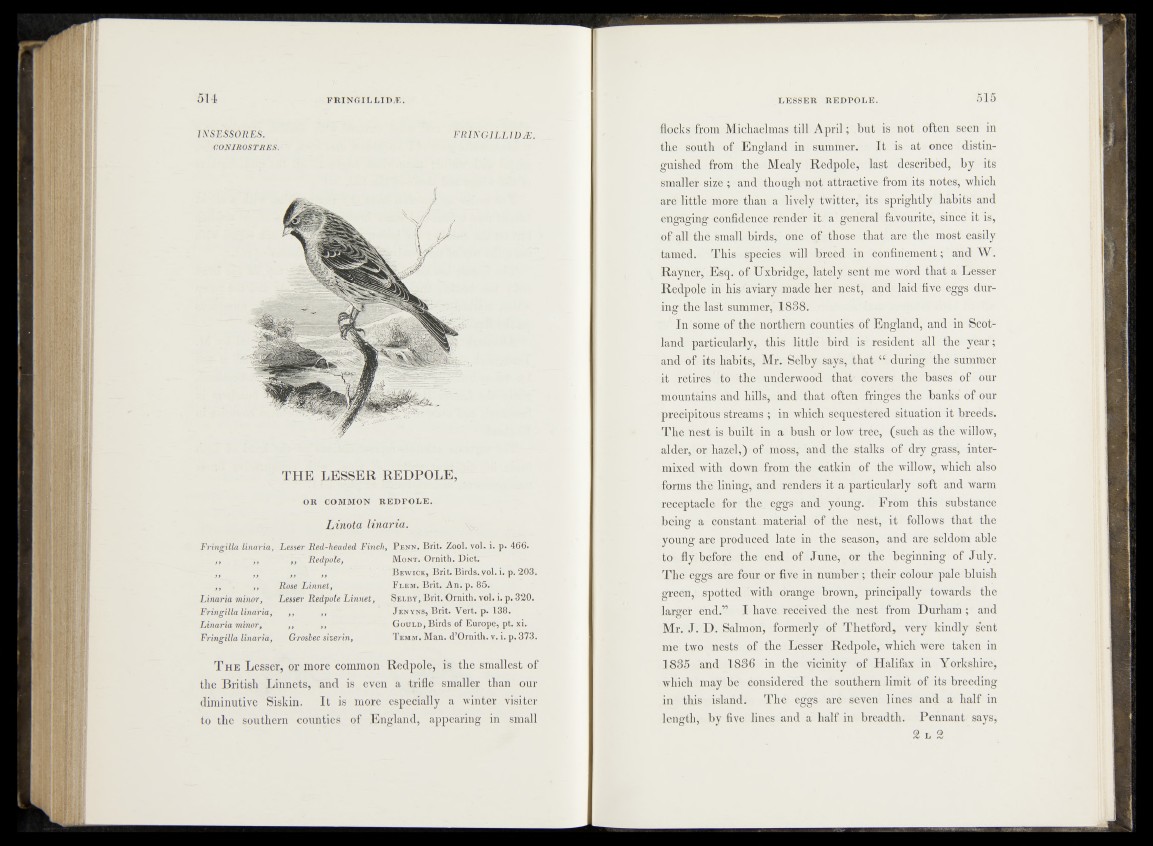
INSESSORES. FRlNGJLLWJE.
CONIROSTRES.
TH E LESSER REDPOLE,
OR COMMON REDPOLE.
Linota linaria.
Fringilla linaria, Lesser Red-headed Finch,
,, ,, „ Redpole,
,, ,, Rose Linnet,
Linaria minor, Lesser Redpole Linnet,
Fringilla linaria, ,, ,,
Linaria minor, ,, ,,
Fringilla linaria, Groslec sizerin,
P enn. Brit. Zool. vol. i. p. 466.
Mont. Ornith. Diet.
Bewick, Brit. Birds, vol. i. p. 203,
P lem. Brit. An. p. 85.
Selby, Brit. Ornith. vol. i. p. 320.
J enyns, Brit. Vert. p. 138.
Gould, Birds of Europe, pt. xi.
Temm. Man. d’Ornith. v. i. p. 373,
T he Lesser, or more common Redpole, is the smallest of
the British Linnets, and is even a trifle smaller than our
diminutive Siskin. I t is more especially a winter visiter
to the southern counties of England, appearing in small
flocks from Michaelmas till April; but is not often seen in
the south of England in summer. It is at once distinguished
from the Mealy Redpole, last described, by its
smaller size ; and though not attractive from its notes, which
are little more than a lively twitter, its sprightly habits and
engaging confidence render it a general favourite, since it is,
of all the small birds, one of those that are the most easily
tamed. This species will breed in confinement; and W.
Rayner, Esq. of Uxbridge, lately sent me word that a Lesser
Redpole in his aviary made her nest, and laid five eggs during
the last summer, 1838.
In some of the northern counties of England, and in Scotland
particularly, this little bird is resident all the year;
and of its habits, Mr. Selby says, that “ during the summer
it retires to the underwood that covers the bases of our
mountains and hills, and that often fringes the banks of our
precipitous streams ; in which sequestered situation it breeds.
The nest is built in a bush or low tree, (such as the willow,
alder, or hazel,) of moss, and the stalks of dry grass, intermixed
with down from the catkin of the willow, which also
forms the lining, and renders it a particularly soft and warm
receptacle for the eggs and young. From this substance
being a constant material of the nest, it follows that the
young are produced late in the season, and are seldom able
to fly before the end of June, or the beginning of July.
The eggs are four or five in number ; their colour pale bluish
green, spotted with orange brown, principally towards the
larger end.” I have, received the nest from Durham ; and
Mr. J. D. Salmon, formerly of Thetford, very kindly sent
me two nests of the Lesser Redpole, which were taken in
3835 and 1836 in the vicinity of Halifax in Yorkshire,
which may be considered the southern limit of its breeding
in this island. The eggs are seven lines and a half in
length, by five lines and a half in breadth. Pennant says,
2 l 2